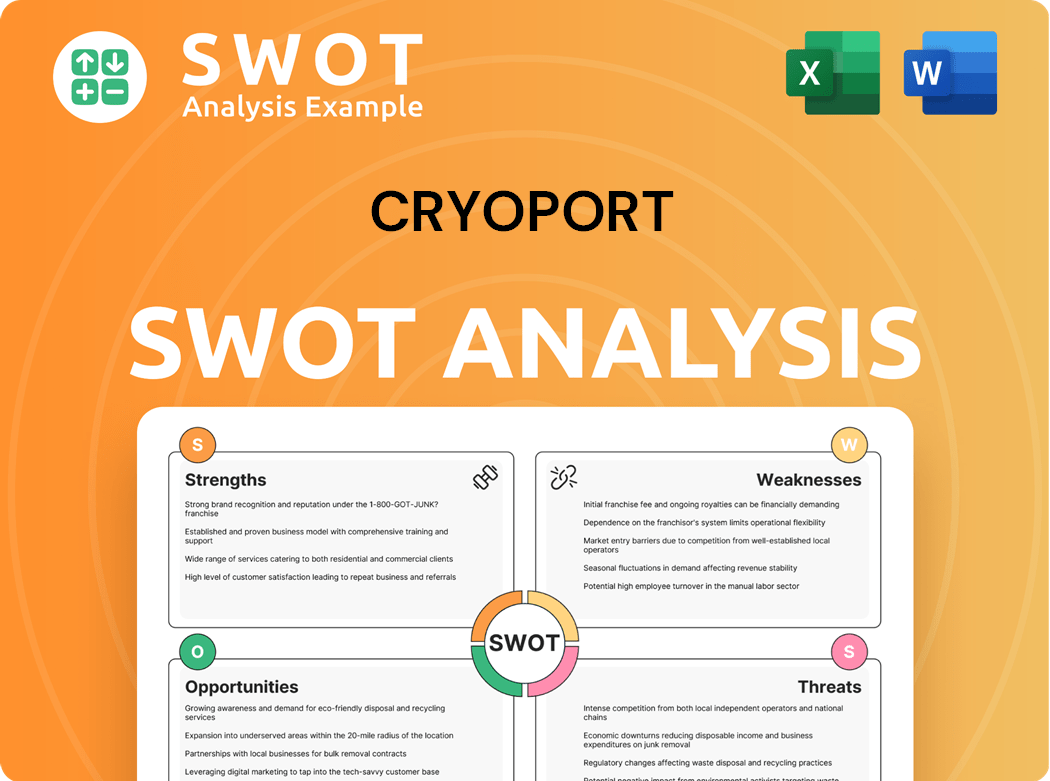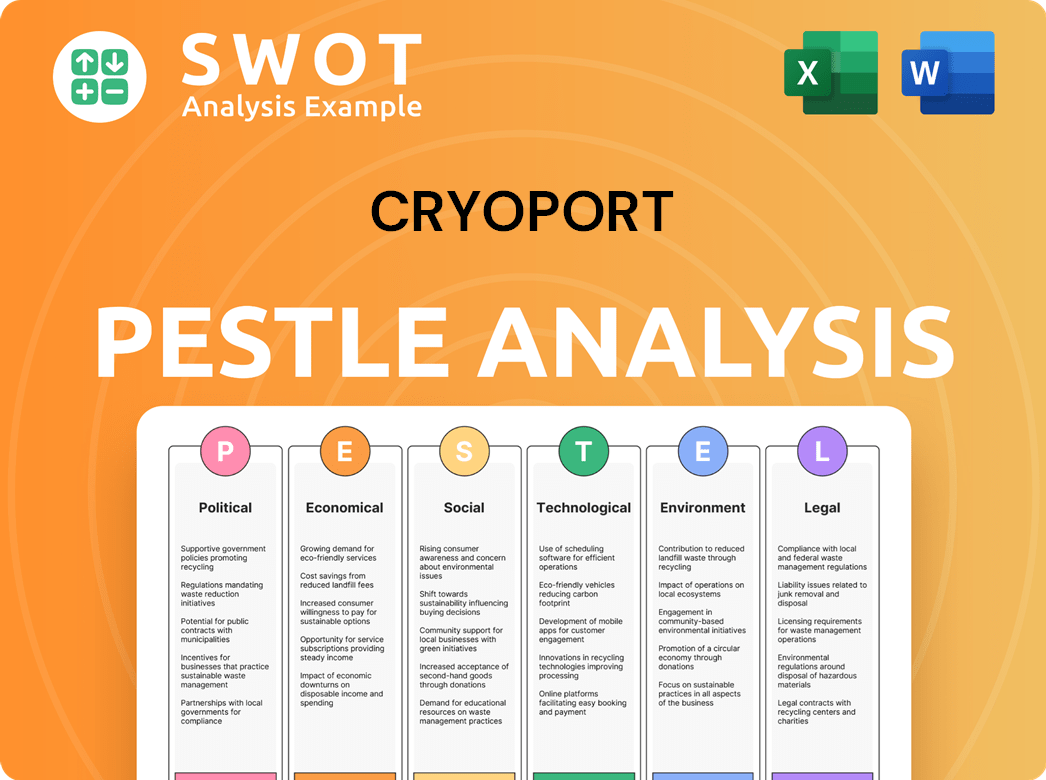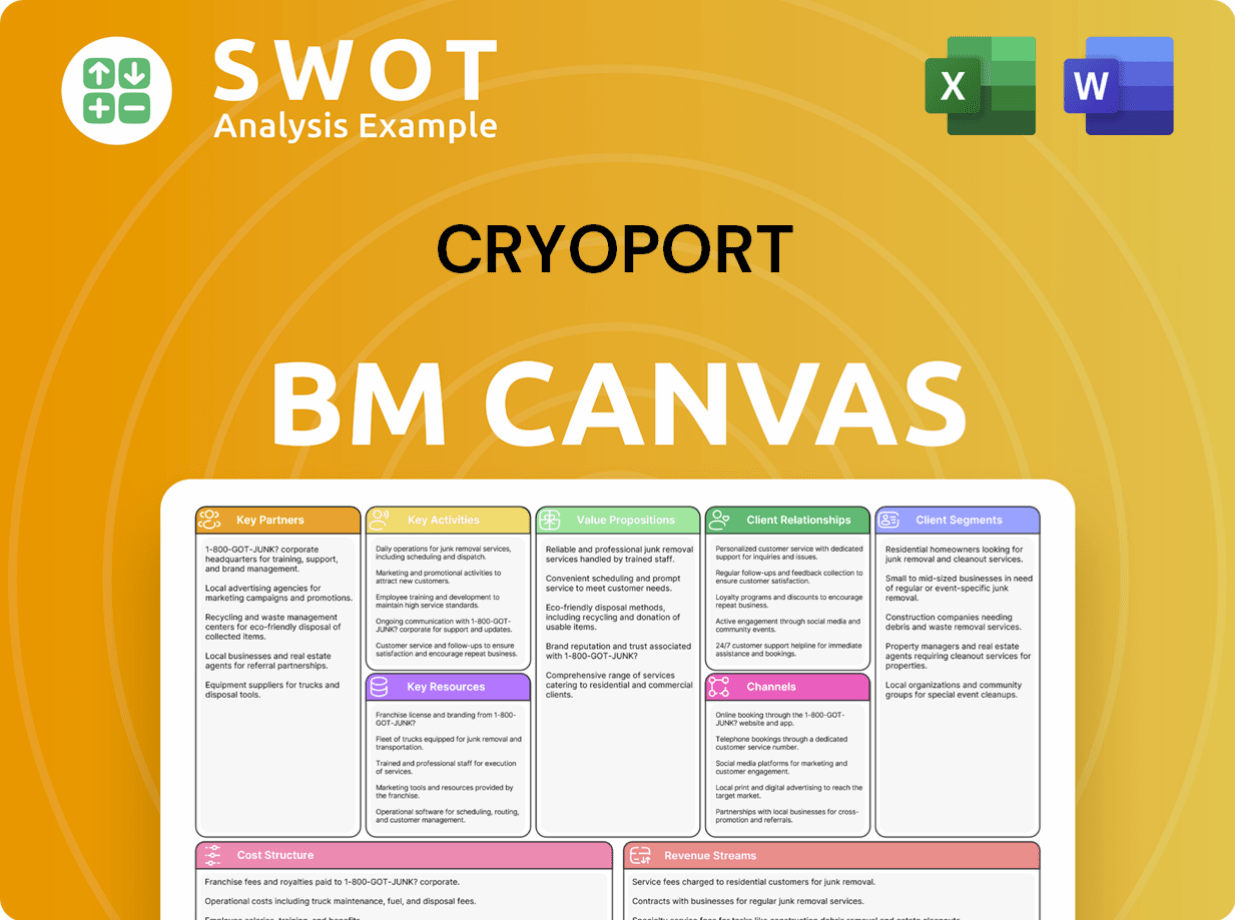Cryoport Bundle
Who Really Controls Cryoport?
In the fast-paced world of life sciences logistics, understanding who owns a company like Cryoport is paramount. Cryoport, a leader in temperature-controlled solutions for vital biological materials, plays a crucial role in supporting cutting-edge therapies. Knowing the Cryoport SWOT Analysis and its ownership structure provides critical insights into its strategic direction and potential for growth.

This deep dive into Cryoport ownership will uncover the key players shaping the company's future. We'll explore the evolution of Cryoport company from its inception, tracing the influence of early backers and the impact of its public listing on Cryoport investors. Discover the current landscape of Cryoport stock ownership and how the Cryoport management team navigates the complexities of the life sciences sector.
Who Founded Cryoport?
The history of the company begins in 1999, founded by a team of six doctors. Noel J. Guillama and Robert S. Barton are specifically recognized as founders in 2000. Their initial vision focused on the shipping of biological materials and supporting the sample bank industry.
The company's initial mission was to introduce a reusable cryogenic dewar to the temperature-sensitive packaging and transport market, offering an alternative to dry ice. In 2005, the company went public through a reverse merger with G.T.5-Limited, a Nevada shell corporation, and began trading on the OTC Bulletin Board.
Details about the exact equity split or shareholding percentages of the founders at the company's start are not available in public records. However, key shareholders played a crucial role in recruiting Jerrell Shelton as CEO in 2012, motivated by their belief in the company's untapped potential, indicating the early influence of specific shareholders. Early agreements or disputes regarding vesting schedules, buy-sell clauses, or founder exits are not explicitly detailed in the available public information. The founding team's vision to provide temperature-controlled logistics for critical biological materials has remained central to the company's business, even as the company evolved its technology and market focus.
Understanding the early ownership structure of the company is crucial for investors. While the exact equity distribution among the founders isn't publicly available, the influence of early shareholders is evident. The recruitment of Jerrell Shelton as CEO in 2012 highlights the role of key investors in shaping the company's direction. The company's focus on temperature-controlled logistics has remained central to its business. For more insights into the company's operations, you can explore Revenue Streams & Business Model of Cryoport.
- The company was founded in 1999 by six doctors.
- Noel J. Guillama and Robert S. Barton are recognized as founders from 2000.
- The company went public in 2005 through a reverse merger.
- Key shareholders influenced the recruitment of the CEO in 2012.
Cryoport SWOT Analysis
- Complete SWOT Breakdown
- Fully Customizable
- Editable in Excel & Word
- Professional Formatting
- Investor-Ready Format

How Has Cryoport’s Ownership Changed Over Time?
The ownership structure of the Cryoport company has evolved significantly since its inception. A pivotal moment was the company's initial public offering (IPO) on March 15, 2005. As of June 11, 2025, the company's market capitalization reached $346 million, with a total of 50.1 million shares outstanding. This transition from a private to a public entity fundamentally altered the shareholder base, introducing institutional and individual investors to the ownership mix.
The shift to a publicly traded entity has led to changes in the composition of Cryoport's ownership. The influence of institutional investors has grown substantially over time, reflecting the changing dynamics of the company's stock. The ownership structure is now largely shaped by the investment strategies of these major institutional holders.
| Shareholder Category | Percentage of Shares (May 2025) | Share Count (May 2025) |
|---|---|---|
| Institutional Investors | 94.79% | N/A |
| Insider Ownership | 3.21% | N/A |
| Mutual Funds (subset of Institutional) | 48.96% | N/A |
The significant presence of institutional investors, holding approximately 94.79% of Cryoport's shares as of May 2025, underscores their substantial influence on the company's strategic direction and governance. The largest institutional shareholders include Cadian Capital Management, LP, Morgan Stanley, and Brown Capital Management, LLC. The relatively low insider ownership, at 3.21% as of May 2025, suggests that the company's strategy is heavily influenced by external investment perspectives. Jerrell W. Shelton, Chairman, President, and CEO, remains the largest individual insider shareholder.
Institutional investors dominate Cryoport's ownership structure, holding a significant majority of the shares. This concentration of ownership influences the company's strategic decisions and financial performance.
- Institutional ownership stood at 94.79% as of May 2025.
- Insider ownership is relatively low, at 3.21% as of May 2025.
- The largest individual insider shareholder is Jerrell W. Shelton, the CEO.
- Mutual funds hold approximately 48.96% of the shares.
Cryoport PESTLE Analysis
- Covers All 6 PESTLE Categories
- No Research Needed – Save Hours of Work
- Built by Experts, Trusted by Consultants
- Instant Download, Ready to Use
- 100% Editable, Fully Customizable

Who Sits on Cryoport’s Board?
The current board of directors of the Cryoport company plays a vital role in its governance and strategic direction. Jerrell W. Shelton is the Chairman, President, and CEO. While a complete list of all board members and their affiliations isn't immediately available in public search results, SEC filings offer insights into beneficial ownership changes for directors. For example, as of June 13, 2025, Director Daniel M. Hancock received 23,214 shares, increasing his direct ownership by 65% to 58,702 units. Similarly, Director Ramkumar Mandalam sold 10,712 units, decreasing his direct ownership by 14% to 66,377 units as of June 13, 2025. Edward J. Zecchini, Chief Digital and Tech Officer, exercised 75,000 shares and sold 51,500 units, increasing his direct ownership by 35% to 90,411 units.
The board's focus, as indicated by company communications, is on advancing Cryoport's position in the life sciences cold chain. The company's performance and strategic decisions are closely monitored by institutional investors and other stakeholders. Understanding the Brief History of Cryoport can provide additional context to the company's current structure.
| Director | Title | Ownership Change (as of June 13, 2025) |
|---|---|---|
| Jerrell W. Shelton | Chairman, President, and CEO | N/A |
| Daniel M. Hancock | Director | Increased direct ownership by 65% to 58,702 units |
| Ramkumar Mandalam | Director | Decreased direct ownership by 14% to 66,377 units |
| Edward J. Zecchini | Chief Digital and Tech Officer | Increased direct ownership by 35% to 90,411 units |
Cryoport's voting structure typically follows a one-share-one-vote system, common for NASDAQ-listed companies. There are no indications of dual-class shares or special voting rights. Major institutional shareholders exert influence through their significant equity stakes. The company has not had any recent proxy battles. The board's focus is on advancing Cryoport's position in the life sciences cold chain.
- One-share-one-vote system.
- No dual-class shares.
- Institutional shareholders have significant influence.
- Board focused on life sciences cold chain advancement.
Cryoport Business Model Canvas
- Complete 9-Block Business Model Canvas
- Effortlessly Communicate Your Business Strategy
- Investor-Ready BMC Format
- 100% Editable and Customizable
- Clear and Structured Layout

What Recent Changes Have Shaped Cryoport’s Ownership Landscape?
Over the past few years, the ownership landscape of the Cryoport company has seen significant shifts. In January 2021, the company raised approximately $287.5 million through a public offering, with net proceeds of about $234.5 million. These funds were earmarked for various corporate purposes, including working capital and global infrastructure development.
A key development in 2025 is the divestiture of CRYOPDP. On March 31, 2025, DHL Group acquired 100% of CRYOPDP from Cryoport for $195 million. This strategic move is part of the company's plan to become carrier-neutral and expand its operational footprint, particularly in the EMEA and APAC regions. Additionally, Cryoport has engaged in share repurchase programs, with authorization to repurchase up to $100 million of common stock and/or convertible senior notes through December 31, 2025. As of December 31, 2024, approximately $73.9 million in repurchase authorization remained.
| Metric | Details | Date |
|---|---|---|
| Capital Raise | $287.5 million | January 2021 |
| CRYOPDP Divestiture | $195 million | March 31, 2025 |
| Share Repurchase Authorization | Up to $100 million | Authorized through December 31, 2025 |
Institutional investors currently hold a substantial portion of Cryoport's shares. As of May 2025, institutional ownership stood at 94.79%. While insider ownership is comparatively smaller, key executives like Jerrell Shelton remain significant shareholders. The company is focused on growing its position in the life sciences supply chain, particularly in cell and gene therapies, with the goal of achieving positive adjusted EBITDA during 2025.
Institutional investors account for a significant percentage of Cryoport's stock. This high level of institutional ownership indicates strong confidence in the company's future. The current percentage of institutional ownership is 94.79% as of May 2025.
Cryoport has a share repurchase program aimed at returning value to shareholders. The board authorized repurchases of up to $100 million of common stock and/or convertible senior notes. As of December 31, 2024, approximately $73.9 million in repurchase authorization was available.
Cryoport divested CRYOPDP to the DHL Group for $195 million. This strategic move allows Cryoport to focus on its core business. The transaction, expected to close in Q2 or Q3 2025, also includes a strategic partnership with DHL.
Cryoport is working towards achieving positive adjusted EBITDA during 2025. The company aims to grow its position as a global leader in supply chain solutions for the life sciences. This includes a focus on cell and gene therapies.
Cryoport Porter's Five Forces Analysis
- Covers All 5 Competitive Forces in Detail
- Structured for Consultants, Students, and Founders
- 100% Editable in Microsoft Word & Excel
- Instant Digital Download – Use Immediately
- Compatible with Mac & PC – Fully Unlocked

Related Blogs
- What are Mission Vision & Core Values of Cryoport Company?
- What is Competitive Landscape of Cryoport Company?
- What is Growth Strategy and Future Prospects of Cryoport Company?
- How Does Cryoport Company Work?
- What is Sales and Marketing Strategy of Cryoport Company?
- What is Brief History of Cryoport Company?
- What is Customer Demographics and Target Market of Cryoport Company?
Disclaimer
All information, articles, and product details provided on this website are for general informational and educational purposes only. We do not claim any ownership over, nor do we intend to infringe upon, any trademarks, copyrights, logos, brand names, or other intellectual property mentioned or depicted on this site. Such intellectual property remains the property of its respective owners, and any references here are made solely for identification or informational purposes, without implying any affiliation, endorsement, or partnership.
We make no representations or warranties, express or implied, regarding the accuracy, completeness, or suitability of any content or products presented. Nothing on this website should be construed as legal, tax, investment, financial, medical, or other professional advice. In addition, no part of this site—including articles or product references—constitutes a solicitation, recommendation, endorsement, advertisement, or offer to buy or sell any securities, franchises, or other financial instruments, particularly in jurisdictions where such activity would be unlawful.
All content is of a general nature and may not address the specific circumstances of any individual or entity. It is not a substitute for professional advice or services. Any actions you take based on the information provided here are strictly at your own risk. You accept full responsibility for any decisions or outcomes arising from your use of this website and agree to release us from any liability in connection with your use of, or reliance upon, the content or products found herein.